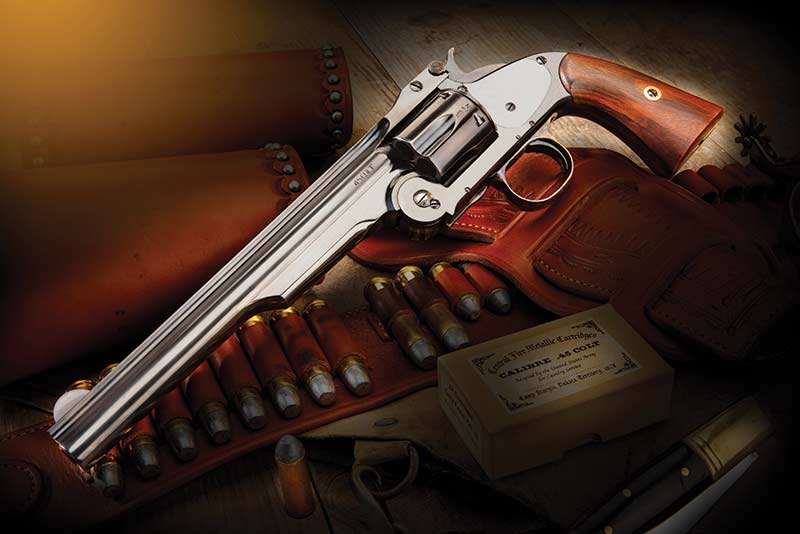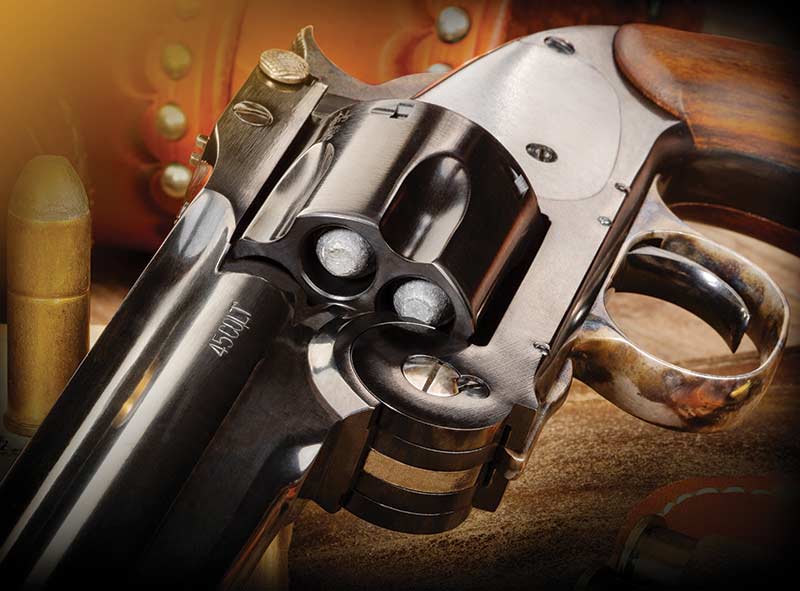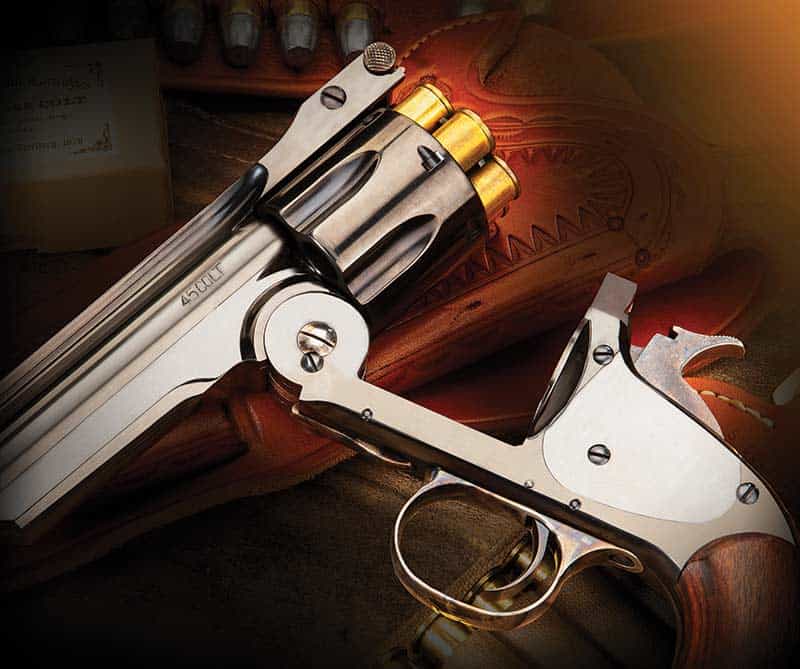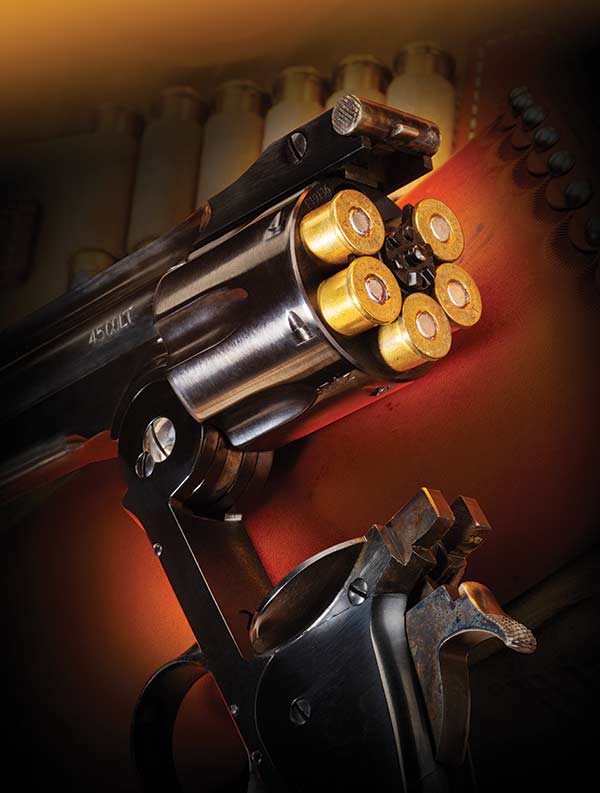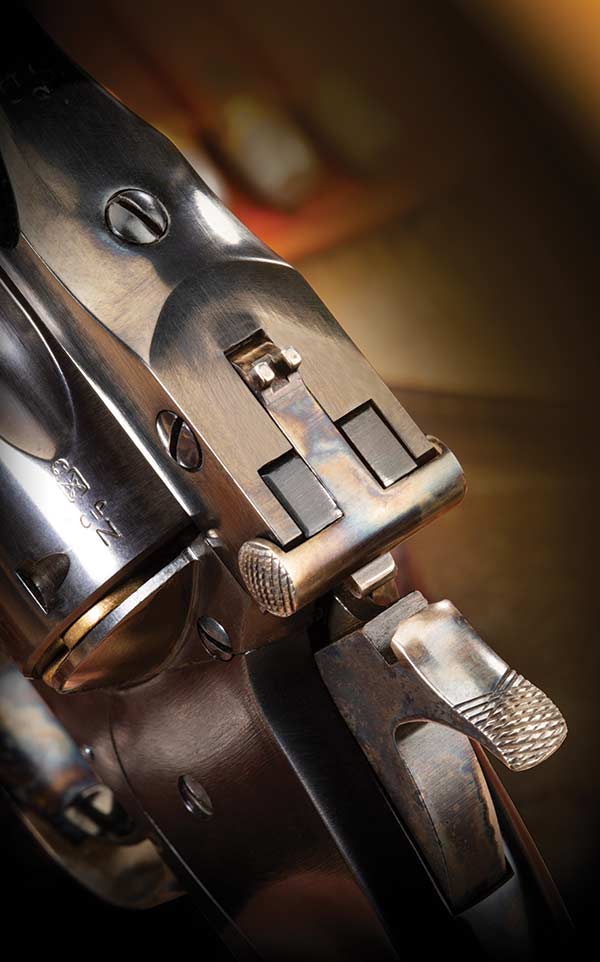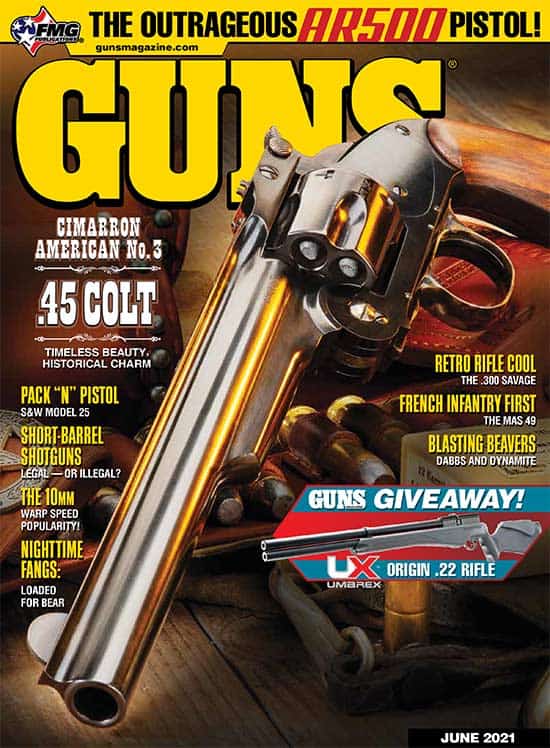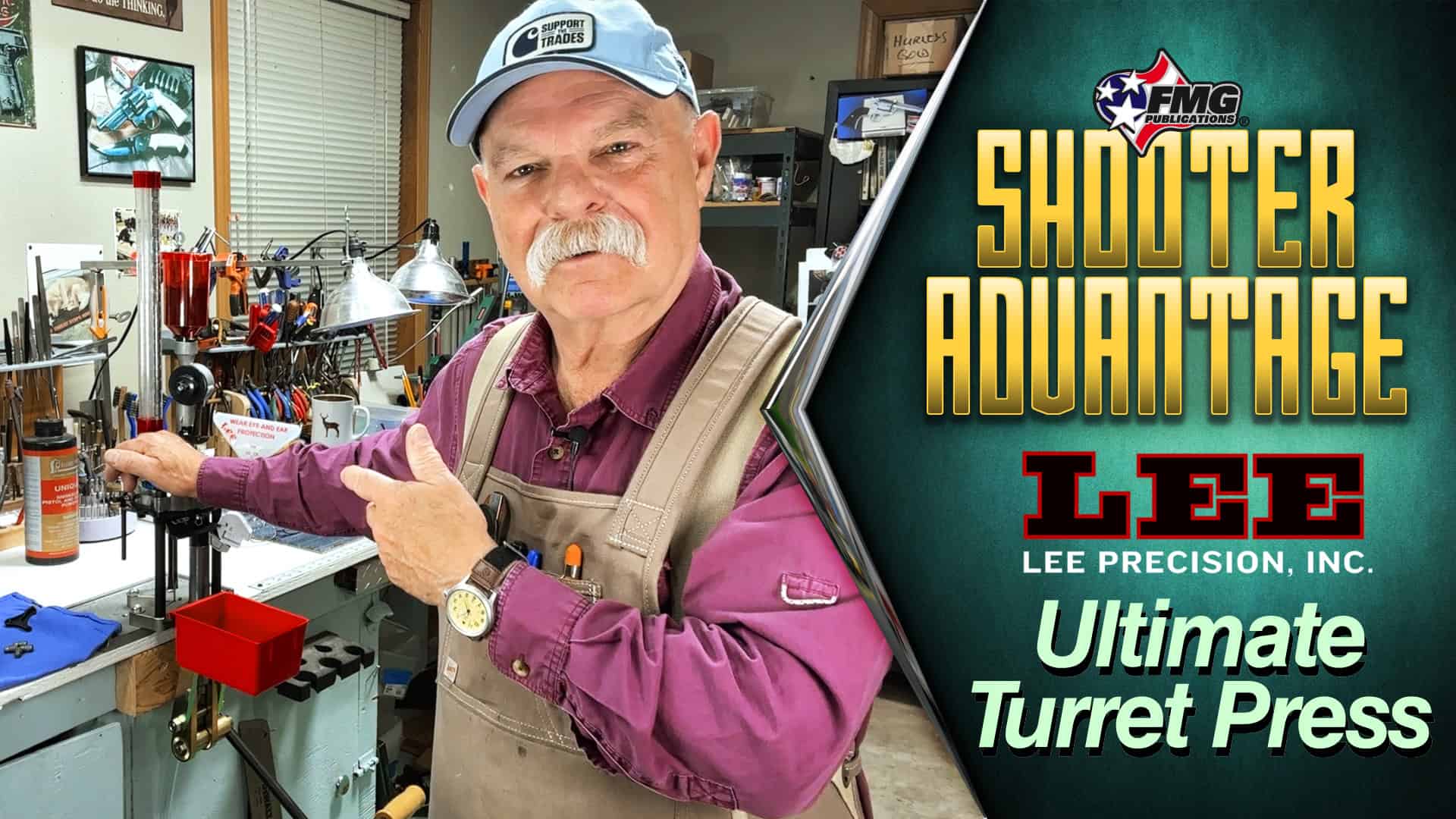Cimarron S&W No. 3 American
Historically Accurate, Impeccably Crafted .45 Colt
Quick … “The first big bore, cartridge-firing center-fire sixgun in the old West.” What gun would you think of? Why, the Colt Single Action of course.
And you’d be wrong, of course. Here’s why —
History at S&W had them developing the No. 1 revolver in 1859 using the ground-breaking .22 Short RF cartridge. This was the first time a metallic cartridge was chambered in a bored-through cylinder and it was an instant hit. The idea of a .22 Short as a defensive gun seems quaint today, but think about it — no muzzle loading chores, fewer mis-fires and the convenience of easy loading and more “cartridges” right at hand. Thousands of these unique “upward tilting barrel” revolvers were carried in the Civil War as back-up guns, also finding their ways into the coat pockets of countless civilians.
As time passed the public wanted a bigger caliber and eventually the No. 2 Army, a sort of biggie-sized No. 1, was developed chambered in .32 RF. It also had the tilting barrel feature. But if you squint your eyes a bit, you can see the beginnings of the outlines of the No. 3 lurking in plain sight.
Then, in 1870, S&W introduced the No. 3 in .44 American and presto, Western history was destined to be changed. The U.S. Army awarded a contract to S&W for the gun, and Russia also bought some 41,000 chambered in what was called the “.44 Russian” to differentiate it from the .44 American. Sales were brisk. The No. 3 was eventually chambered in .44 Henry, .44-40, .32-44, .38-40 and .45 Schofield.
Army Changes
The various No. 3 Models can be confusing but if you think of them as being the same gun with very minor changes, it can calm the nerves somewhat. A big change involved the ones designed by Major George Schofield (there’s the name) in 1875, consisting of changes he felt were needed to make it a more battlefield-worthy revolver. One change allowed a cavalryman to open the revolver with one hand and tilt the barrel by flipping it, ejecting the empties. Then a reload, and you’re back in the fight. The standard No. 3 requires two hands to unlock and open the action.
The Army also wanted S&W to chamber the “Schofield” in .45 Colt but alas the cylinder wasn’t long enough for the full-size Colt cartridge. S&W instead offered a “.45 Schofield” (.45 S&W) cartridge — a shortened .45 Colt. But alas, with so many Colt SAA revolvers in use chambering the full-sized round, and the fact the Colts could shoot either, the Army eventually dropped the Schofield design from general issue use. It might interest you to know the wholesale price at the time was about $14 or $278 in today’s money.
Many of these military guns were sold and became very popular with both the good guys and the bad guys, while the military still kept many in stock for back-up issue. These were used in the Spanish-American War and the Philippine-American War.
Names like Jesse James, Bob Ford, John Wesley Hardin, Pat Garrett, Theodore Roosevelt, Virgil and Wyatt Earp, Billy the kid and others carried No. 3 revolvers. We’re pretty sure Wyatt and Virgil had No. 3s at “That Gunfight” in Tombstone. Wells Fargo and Company bought thousands of the surplus Schofields, cutting the 7″ barrels to 5″ and re-stamping them with “W.F. & C” turning them into instant collectibles today. But, alas, beware of fakes.
Believe it or not, production of the No. 3 variants continued until 1915. Before the advent of general sales of the Colt Single Action, the No. 3 was clearly the best game in town, which may explain its long legs.
Perhaps one of the biggest legacies of the No. 3 design is the fathering of the first big-bore DA sixgun for S&W, the famous top-break S&W .44 Double Action First Model. Able to be fired single or double action, the top-break design, external hammer, well-shaped grip and .44 Russian and .44-40 chambering introduced the first high quality big bore DA revolver for the brand. The rest is history, and we owe all of the famous S&W DA revolvers we love today to that gun. And perhaps, in due course, to the No. 3.
Cimarron
It simply gives me no end of genuine pleasure to talk about this fine company and the people behind it. Mike Harvey, owner and president, started with a modest gun store in Texas and during a turn in business, discovered the imports from Italy replicating famous old west firearms. But Mike being Mike, his penchant for authenticity drove him to Italy where he met and befriended Aldo Uberti. Since the beginning, Mike and the team at Uberti worked hard to properly replicate the original design, feel and quality of the various classic old west designs. It sounds easy but it wasn’t.
Mike’s personal collection of authentic old west firearms paved the way for Uberti to bring in the first truly authentic Colt Model P (SAA). The Italian “clones” of the time (in the early 1980s) looked generally like a Colt Single Action but there were serious flaws in cosmetics, design and engineering. The top straps were much too thick, almost twice those of an original Colt and the flats, curves and evidence of the delicate hand workmanship of the original Colt artisans was often lacking. While the Uberti team was excellent, they simply had no experience with the originals.
Mike fixed that. He made sure Uberti was able to reverse-engineer one of Mike’s very early Colts down to the last pin. Since then, Mike has made countless trips to Italy to meet, work with and help them hone the many models Cimarron has introduced over the years — he even has his own desk at their factory!
Mike’s passion for the old guns and keeping his products as authentic as possible essentially helped change the way Americans see the Italian guns. Mike’s demand for high quality, authentic builds and correct finishes pushed other companies here and in Italy to up their game. I have no issue at all saying if it wasn’t for Mike’s personal commitment, today the rich round-up of high quality imported guns like Cimarron’s simply wouldn’t exist. Mike doesn’t just “buy what’s there” and import it — he continues to work with a broad cross-section of companies outside the U.S. to assure the various models he offers are all correct in every respect.
As proof, you only have to look at movies like the True Grit remake, Unforgiven, Lonesome Dove, The Lone Ranger, Young Guns II — and too many others to list — to see Cimarron gets it right. If you’re like me, when I see a movie showing guns out of sync for the times it takes away from the whole experience. Cimarron’s line-up makes it easy for history to repeat itself — correctly.
Our No. 3 American
Think of our test gun as a first generation No. 3 but with a couple of slight changes to accommodate the .45 Colt cartridge. Under Mike’s close watch, Uberti has replicated the original as closely as possible while lengthening the cylinder to handle the longer .45 Colt round, as well as the original .44-40, .44 S&W and Russian and the .44 Special. From looking, I believe they didn’t lengthen the cylinder “window” but shortened the bushing flange or ring at the front of the cylinder to fit inside.
Details include period correct color case hardening on the hammer, top latch and trigger guard. The original-style grip frame and accurate two-piece walnut grip is here too. You can also get one with correct markings for a military-issue version. The finish is a deep, rich bluing coming out more black and looking like minty originals I’ve seen. Nickel is also offered and was very popular in the day due to the black powder cartridges used and the tough life on the trail.
Barrel lengths are 8″ (our test gun) and a very handy-to-tote 5″ model. I wanted first-model authenticity so I asked for the longer barrel, but a shorter one may be in the cards too. I also think they’re particularly handsome and fierce-looking with a 3.5″ barrel. Mike, are you listening?
One of the nearly miraculous things Mike accomplished is to figure out ways to keep the myriad of mandated Italian proof marks out of sight, or at least as much as possible. Early imports were littered with the “approval” stamps from a dozen or more tests the revolvers had to pass in order to be approved for sale. I’ve seen those guns and it often looked like some kid got a metal stamp kit and went to work with crowns, swords, letters and numbers. Mike’s methods to hide these hideous attacks on the glory of these designs pays dividends in personal enjoyment for us. When you hold any Cimarron firearm you have to peer very hard in order to decide if what you’re holding is a rare and wonderous original — or an authentic reproduction.
Sheer Delight
Shooting something like the No. 3 is the whole thing, isn’t it? To hold it, cock it and touch it off is to relive a past still very much alive in our history, legends and just plain wishful thinking. The click of the hammer engaging the sear, the cold trigger against your finger, the heft lent by the long barrel and the easy rolling in your hand when the big bullet leaves the barrel — all grabs at the heart. If you don’t feel it, I’m sorry for you.
This gun was never meant to shoot tiny groups on targets way out there. Although, even with the minuscule original-style sights — complete with sun glaring off them — I was able to coax 1.75″ groups to appear at 25 yards. In all honesty, if I had better eyes and it had better sights, who knows what this amazing gun could do? I had not planned on targeting this very much, mostly just wanging at steel, but this changes everything as they say. It’s also all modern steel, so as long as you don’t get silly, you could certainly load it with ammo suitable to protect your skin or to shoot a wily pig or three. But do carry it with five and then hammer down on an empty chamber!
Suffice to say, when this No. 3 sits on my desk, I feel like I need to pick it up, point it with a fierce scowl, and cry out, “Unhand her, you ruffian, or I shall have to shoot!” No … really. You will too. I feel a new cowboy Slim Jim holster in my future. I live in Missouri, and, well, Jesse James “worked” here and loved his No. 3, and … and … and.
Call this a collaboration of American entrepreneurship striving for excellence and joining forces with talented gun builders from around the world. If you’re smart, you’ll also call one yours soon.

